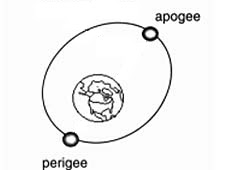Planet Saturn is tilted in relation to its orbital path around the Sun. As it chugs around the Sun— in an orbit that lasts 30 Earth years— sometimes its rings are tilted open from our vantage point, showing us either the “top” surface of the rings or the “bottom.” And twice during its orbit, that is, every 15 years, we experience a ring plane crossing, when our view of Saturn is side-on or edge-on, and the remarkably thin rings disappear from view.
The next ring plane crossing is coming up quickly and will occur in September of 2009. Because of this, the rings have been gradually closing from our perspective. By the end of this month, they’ll be less than one degree open. Imagine an angle measuring one degree: that’s really small! Since Saturn will be quite close to the Sun in September and therefore not well placed for us to view the vanishing of the rings, this is an excellent time to sneak a peek. After all, what’s one silly little degree among friends?
Grab your telescope, beg or borrow a telescope, or look for telescope observing opportunities through your local observatory, planetarium, science museum, or astronomy club. This is no time to be shy!
1) To spot Saturn, you’ll need to face east. If you don’t know the cardinal directions at your location and you don’t have a compass, make note of where the sun sets on the horizon. That spot is approximately west. Stand with your back to the west, and you’ll be facing approximately east.

2) About an hour or so before midnight, Saturn will rise over the eastern horizon, behind Regulus, the bright star that marks the Lion’s Heart in the constellation Leo. You may also recognize Regulus as the star marking the bottom of the asterism that looks like a backwards question mark, the one called the Sickle. An asterism is a recognizable star pattern. Saturn will be brighter than Regulus, and it will have a golden color.
3) The later in the evening you can wait to observe Saturn, the better. The higher Saturn is in the sky, the less atmosphere you’ll be looking through. Generally speaking, this translates to a clearer, steadier image in your eyepiece.
4) Once you have the golden planet in view, you’ll notice the nearly edge-on rings. When I observed Saturn recently, this is what I saw:

It was quite startling to see no ring plane surface. Rather, there was the effect of a straight line, white on the ends outside the planet’s disc and black where it crossed the disc. The black line is the shadow of the rings cast onto the surface of the planet by sunlight.
5) What I also observed, which you can see quite readily, was Saturn’s slightly squashed shape. Because the planet is a rapidly spinning sphere of gasses, it has developed an equatorial bulge, that is, it bulges along its equator. Having just indulged in Christmas dinner, I can certainly relate.
With the incredibly bright rings out of the way and a sideways view, now we can enjoy what is often overlooked: the oval shape that resembles a sat-upon beach ball.
6) To finish up your communion with the ringed one, look for the usual sprinkling of moons just beyond the edges of the rings They’ll look like little stars, and it’s a fun challenge to see how many you can spy.
See you next year!

Credit: NASA/JPL







